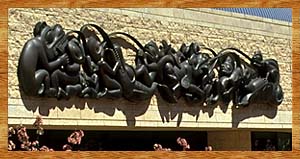 Bill Reid Bill Reid
 Robert Davidson Robert Davidson
 Jim Hart Jim Hart
 The Next The Next
 Generation Generation
 |
Bill Reid
The renaissance of Haida art begins with a story that has become apocryphal. One fateful day in 1956, Bill Reid, whose mother was a Haida from Skidegate and whose father was a German American, was reading the news as an announcer for CBC Radio in Vancouver: the news item that changed his life was about a grant to recreate the totem poles and houses of a Haida village on the campus of the University of British Columbia. Reid says that he turned off his microphone right after the newscast and phoned the university's Museum of Anthropology to offer his assistance in pursuing this goal. It proved to be his apprenticeship in rediscovering Haida art and led to almost a half century of pioneering work in cultural reconstruction.
Bill Reid honed his skills over many years through replicating works created by his forebears, especially his great, great uncle, Charles Edenshaw. He studied the several hundred pieces of gold and silver jewellery by Charles Edenshaw in museums and copied images from John R. Swanton's Contribution to the Ethnography of the Haida, from Franz Boas's Primitive Art and from books by Marius Barbeau on Haida myths and argillite carvings.
This apprenticeship period led to a mature artistry in gold and silver jewellery that set new standards of value among eager collectors and has been well documented. Eventually, Reid undertook a series of public sculptures, each of which took the art world by surprise because of its increasing innovativeness, not to mention ever-growing scale. These completely new works went far beyond traditional prototypes and brought an indigenous style for the first time to the national level in Canada. Ultimately, Reid's work was recognized on the international level with exhibits in Paris, Budapest, Tokyo and Washington.
Beginning with his large cedar sculpture titled The Raven and the First Men, commissioned in 1980 by Dr. Walter Koerner for the Museum of Anthropology at the University of British Columbia, Reid pushed Haida art into a format well beyond the house frontal pole or mortuary post. His second work on a large scale, the bronze Killer Whale for the Vancouver Aquarium in 1984, is closely related to Charles Edenshaw's compotes or fruit dishes that featured pivotal figures of Haida cosmology as the handle of the lid. A prototype for this sculpture was the gold box he made for the Royal British Columbia Museum in 1971, on which the tightly arched Whale forms the handle of the lid. This Whale is all of 7.6 cm (3 inches) high while the monumental bronze version is 5.5 m (18 feet) high. His next large piece, in 1984-85, was a bronze relief mural, Mythic Messengers, for Teleglobe Canada's headquarters in Burnaby, near Vancouver.
 |
Mythic Messengers (at the Canadian Museum of Civilization)
CMC LH991.2821.1 |
Expo 86 in Vancouver coincided with an obsession Bill Reid had developed for understanding the Haida canoe as a paradigm of Haida culture. Its pivotal role was recognized by the Reverend William Collison, who titled his reminiscences of the first mission to the Haida In the Wake of the War Canoe. Reid was commissioned to carve and paint a 15-m (50-foot) war canoe from a red cedar log for the world's fair. He agreed to recreate this canoe, which he named Lootaas (or Wave Eater) for the Canadian Museum of Civilization in fibreglass to offset the swings in climactic conditions. Each new canoe was to be the alter ego of the other: one was to have primary formlines in black, the other in red. Consequently, one canoe became known as Black Eagle while the other was known as Red Raven.
The pièce de résistance of Bill Reid's work is surely The Spirit of Haida Gwaii, commissioned by the firm of R. J. Reynolds for the new Canadian Embassy in Washington, D.C. This massive sculpture, which took more than three years to execute and resulted in a price tag of $1.8 million, was unveiled in 1992. The plaster pattern for the bronze cast was a perfect complement to the baroque plaster interiors that architect Douglas Cardinal had created for the new Canadian Museum of Civilization. Long before the completion and opening of the museum in 1989, I had suggested to Maury and Mary Young of Vancouver, the eventual donors, that The Spirit of Haida Gwaii would be the crowning piece in the Grand Hall, signalling that Northwest Coast native culture was not extinct but was, shamanlike, rising from the ashes.
In Memoriam, Bill Reid
(1920-1998)
|